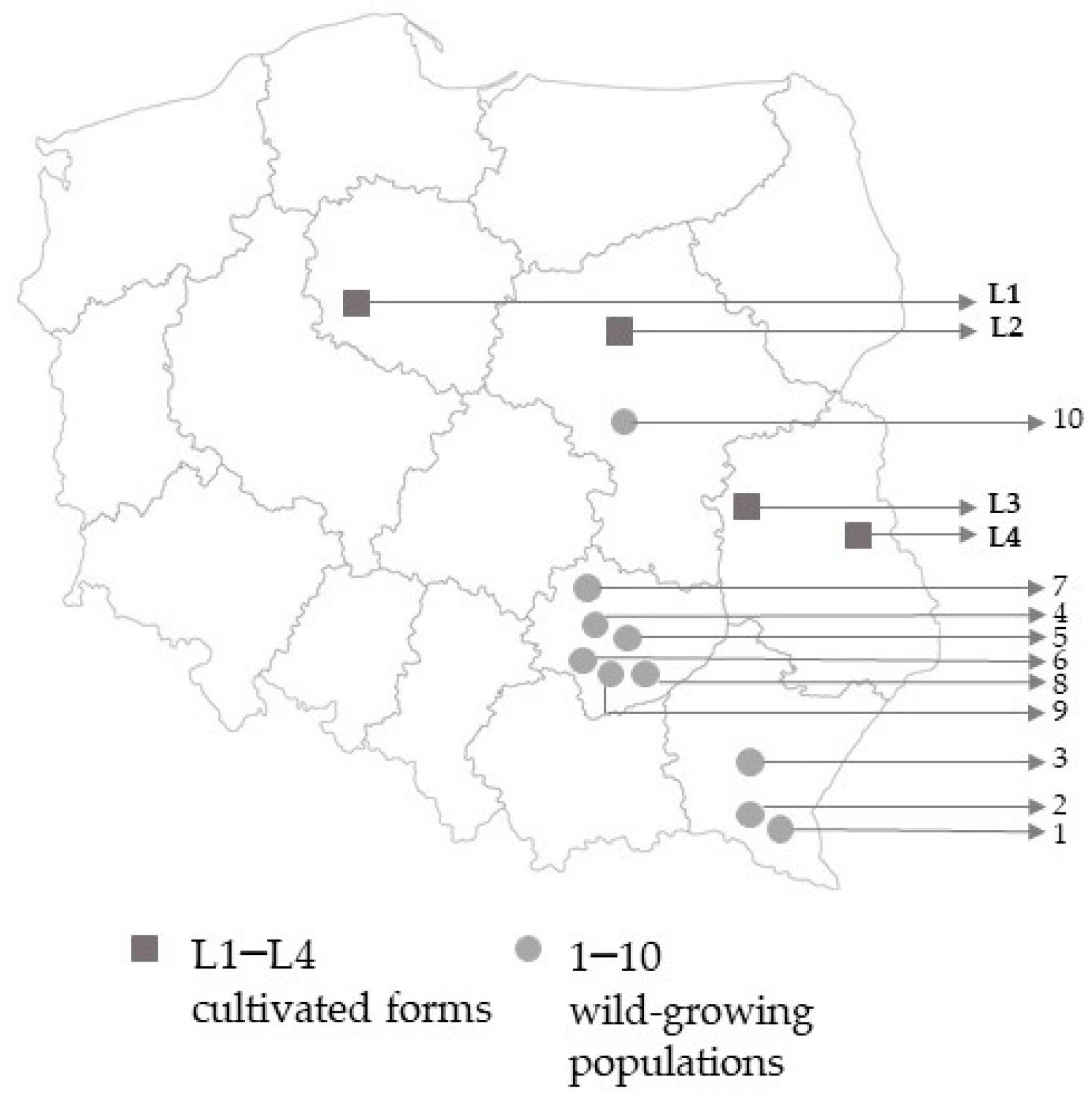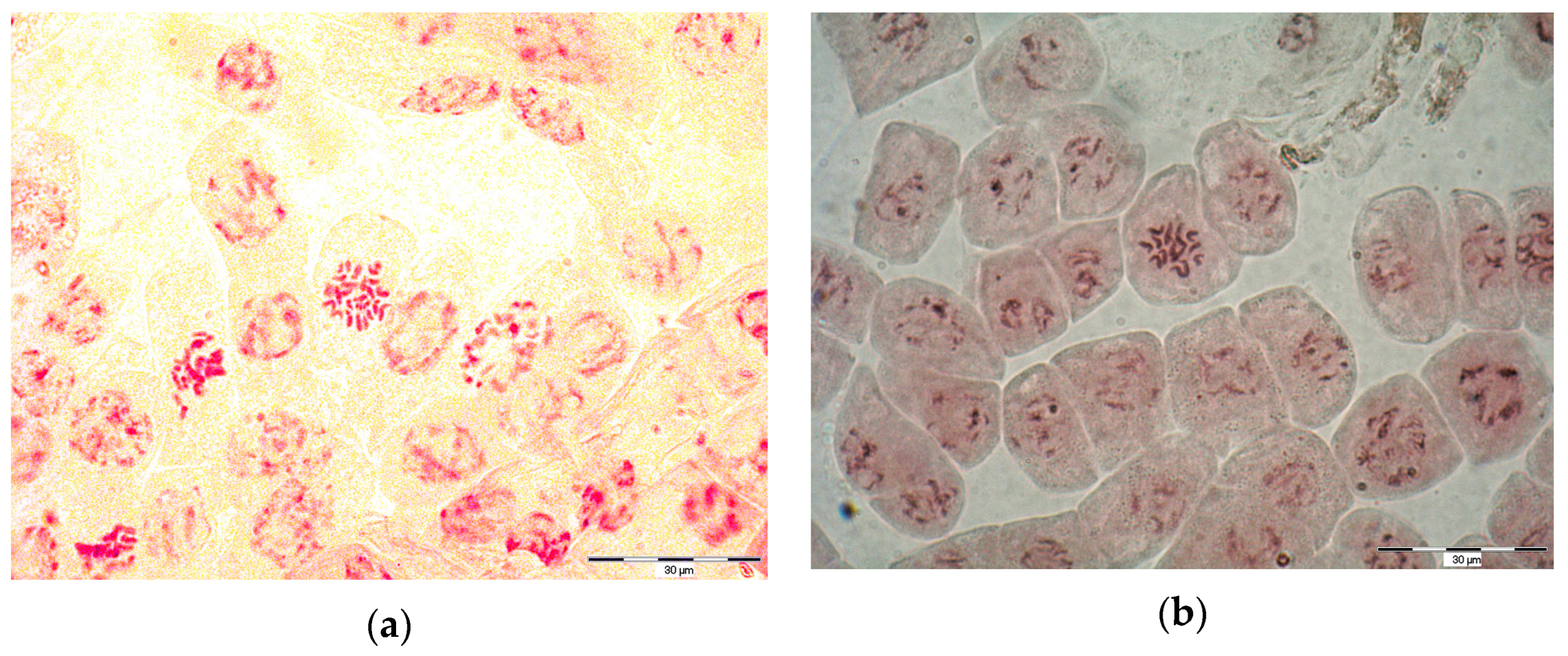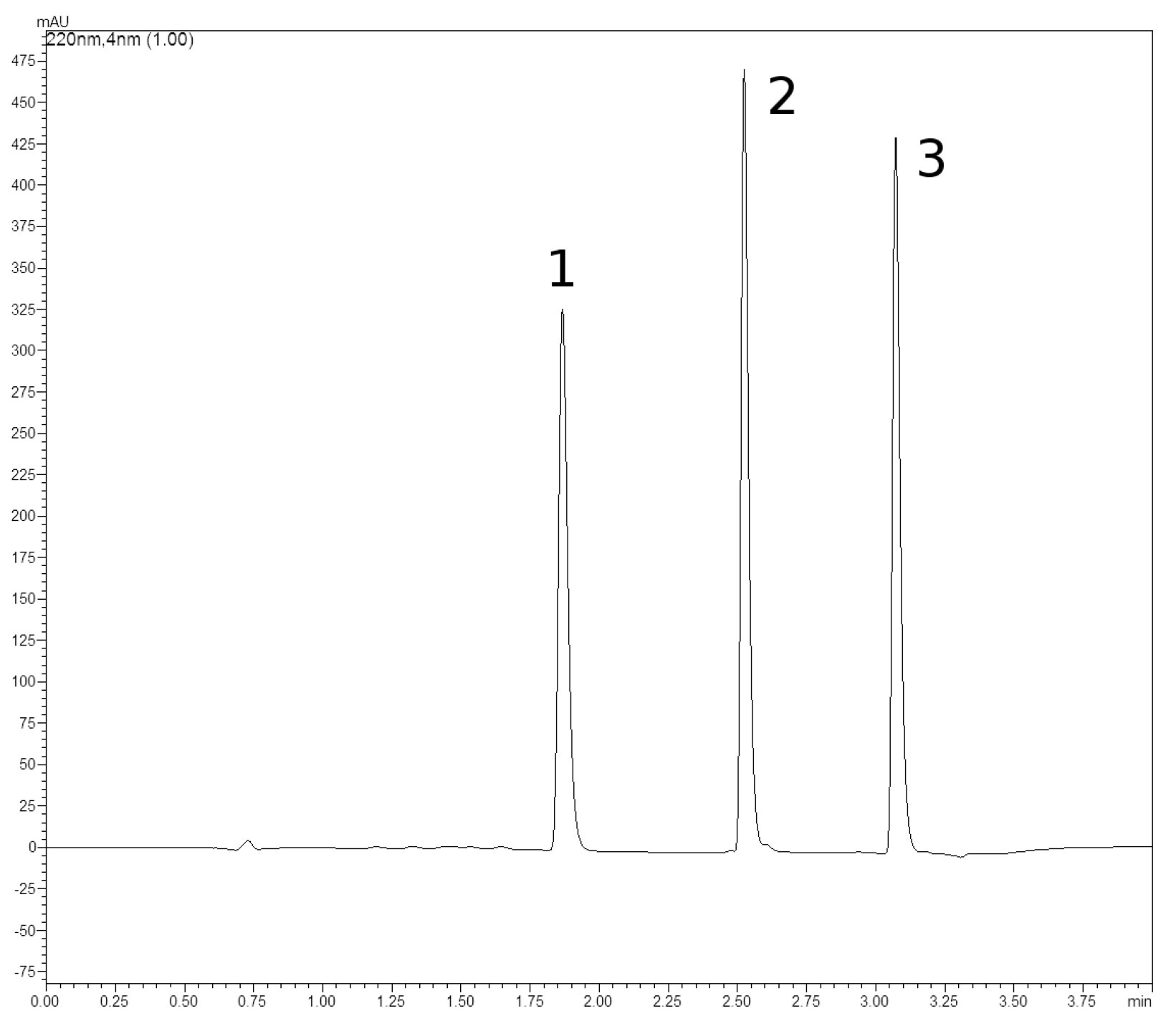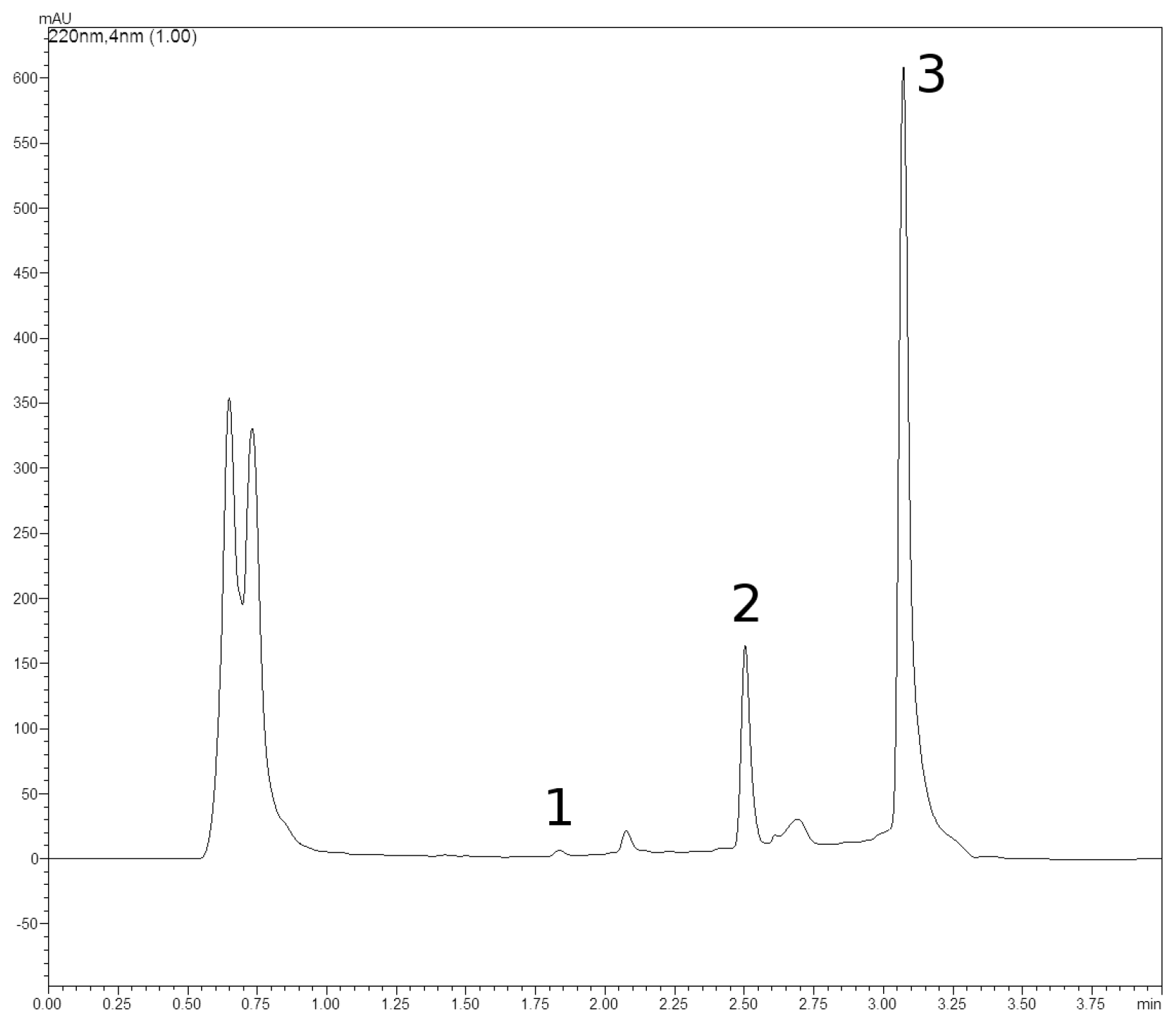1. Introduction
Wild-growing common valerian (
Valeriana officinalis L. s.l.; Valerianaceae) originates from temperate regions of Europe and Asia. In North America, it has been naturalized. Its populations are found on riverbanks, in wet meadows and low peat bogs, on sunny edges of forests (usually dominated by alder), amid scrub, and on roadsides. Being extremely polymorphous,
V. officinalis constitutes an aggregate taxon with a complex of subspecies. Up to now, three basic ploidy levels have been identified within the species: diploid, tetraploid, and octoploid. Aneuploidy was detected among some Italian populations as well [
1,
2,
3]. Common valerian develops as a rhizomatous rosette-forming clonal perennial plant with solitary hollow stems reaching 2 m in height, with pale pink to white strongly scented flowers at the top [
4].
The herbal raw materials collected from this species are underground organs consisting of a vertical rhizome bearing numerous roots and some stolons, commonly named valerian root. Currently, the raw material from which the medicinal products are produced originates exclusively from cultivation and is subjected to standardization. According to the European Pharmacopoeia [
5], the dried, uncut, or fragmented valerian root (
Valerianae radix) should contain no less than 0.17% sesquiterpenic acids (commonly named valerenic acids) and no less than 4 mL × kg
−1 DW of essential oil (EO). In Europe, the drug is applied based on both well-established and traditional use [
6]. Preparations thereof are available here mainly in the form of dry extracts (extraction solvent: ethanol 40–70%
v/v). Other forms of valerian preparation are also in use, including comminuted or powdered drug used to prepare an infusion, juice from fresh roots, and diverse liquid extracts and tinctures for oral use. Comminuted herbal raw material or preparations thereof are also used in liquid forms as a bath additive [
6]. In turn, in the US and Canada valerian root is approved as a dietary supplement (considered as food), being generally recognized as a traditional herbal sleep aid. With reference to the EMA/HMPC monograph, valerian preparations are indicated for the relief of mild nervous tension and sleep disorders (according to well-established use) and for the relief of mild symptoms of mental stress and as sleep aid (according to traditional use). Moreover, valerian root products show no risk of forming dependence as may often occur with synthetic sedatives. Such important effects of these preparations make them one of the most frequently purchased herbal remedies in Europe and the US [
7,
8]. However, it is still not possible to demonstrate a clear relationship between the clinically confirmed efficacy of valerian as a sleep-promoting drug and specific compounds present in this raw material. This efficacy probably depends on an interplay between many groups of compounds [
9]. These include EO (0.1–2.8%), consisting of a mixture of mono- and sesquiterpenoids. The major monoterpenes here are borneol and its isovaleric and acetyl esters or acetates. As for sesquiterpenes, the major specific ring systems unique to the Valerianaceae are visible in the valerian EO. These include kessane and elemane ring types, of which valeranone is an important compound, as well as valerenal and valerenic acids. Valerian root contains also 0.1–2.0% valepotriates (monoterpenes belonging to the iridoid group), with valtrate and isovaltrate being dominant, and characteristic-free sesquiterpenic acids such as valerenic and hydroxyvalerenic acids, which have so far not been detected in any other species than
V. officinalis. Thus, their presence is used in drug identification. Moreover, the raw material contains some lignans (about 0.2%), traces of alkaloids, phenolic acids, and fatty acids and their esters [
10,
11,
12,
13].
For centuries, valerian root was collected from wild-growing plants. As mentioned above, nowadays, the material for commerce originates exclusively from cultivation, mainly from Poland, Belgium, The Netherlands, Germany, the Czech Republic, Ukraine, Hungary, and the United States. The varieties used for crop production are represented predominantly by improved populations created using simple breeding selection or crossbreeding methods [
14]. In Poland, the species was introduced into broader cultivation in the 1950s. Since then, farmers have carried out their own selection based on wild-growing populations (usually diploid forms), mainly in terms of root weights, in order to improve the yield. As a result of this work, a local cultivar was created and named ‘Lubelski’ after the region where it had been developed. The cultivar was identified later as
V. officinalis subsp.
latifolia (
tenuifolia) and classified as a tetraploid characterized by thick roots and a high content of essential oil [
15]. ‘Lubelski’ is still being improved by farmers and is widely cultivated in Poland and neighboring countries. However, farmers’ own seed reproduction, combined with the selection of plants intended for this purpose, carried out locally in various regions of Poland, contributes to increasing the range of variability in this population variety and creating its local forms (subpopulations). Thus, such population varieties show high heterogeneity in the yield and content of active constituents in the raw material [
14].
In order to undertake further breeding programs aimed at improving yield-creating traits and levelling the content of active compounds in raw materials obtained from such population varieties, first it is necessary to assess the range of diversity of the forms used so far. The aim of the study was to determine the range of the variability both within and between ‘Lubelski’ forms of valerian originating from four remote cultivation regions of the plant, with reference to the diversity of indigenous wild-growing populations that are the ancestors of the currently cultivated forms.
2. Results and Discussion
The results obtained confirm our previous observations concerning the variability in the functional traits of valerian. The weight of the roots collected from wild-growing populations was over three times lower than the mass of the raw materials collected from ‘Lubelski’ forms (22.66 and 74.37 g DW per plant, respectively). However, the variability (expressed as the coefficient of variation, CV) between wild-growing populations and between cultivated forms was similar (27 and 25%, respectively). The four forms of the ‘Lubelski’ cultivar differed markedly from each other in the root weight (from 48.7 to 90.74 g DW per plant), and they were also strongly internally differentiated concerning this trait (CV: from 49 to 75%) (
Table 1). As a result, the diversity between the forms was lower than the diversity within the forms. The L2 form appeared to be the most uniform in terms of this trait, indicating the better efficiency of the selection work carried out by farmers in the region of its origin. Although cultivated on a large scale, the data concerning the yields of the ‘Lubelski’ cultivar are relatively scarce. According to Wiśniewski et al. (2016), the dry mass of the ‘Lubelski’ underground organs amounts to 63.9 g per plant, which is comparable with our results; however, no data on the diversity of this trait among ‘Lubelski’ plants are available [
16].
The results obtained in our work also illustrate the effect of ploidy on the functional traits of valerian. The basic chromosome number of
V. officinalis is x = 7 [
17]. Among the species, diploids (2x = 14), tetraploids (4x = 28), and octoploids (8x = 56) have been repeatedly found [
3,
18,
19,
20]. Recently, a hexaploid population (6x = 42) and populations consisting of individuals with different numbers of chromosomes have been identified as well [
3,
21]. In our experiment, the plants originating from wild-growing populations were diploids, while all the ‘Lubelski’ forms were identified as pure tetraploids (
Table 2). It can be assumed that the higher root weight of the cultivated tetraploid forms was related to the higher number of chromosomes, which was pointed out earlier by many authors [
10].
According to the European Pharmacopoeia [
5], the content of sesquiterpenic acids in the dried, uncut, or fragmented roots should not be lower than 0.17%. Among these acids, the most important ones are valerenic (VA) and acetoxyvalernic acid (AVA). Therefore, this group of compounds (sesquiterpenic acids) is commonly known as valerenic acids. The content of VA seems to be crucial here because, in clinical studies, the anxiolytic activity of the compound was confirmed [
12]. In our study, the content of these compounds was distinctly lower in wild-growing populations (0.013%) compared to cultivated forms (0.321%). In contrast to the weight of the roots, the differences concerning this trait between wild-growing populations were several times larger (CV 59%) than the variation between cultivated forms (CV 18%). The content of valerenic acids varied between forms from 0.281 (L1) to 0.394% (L2). However, the forms were strongly internally differentiated in this trait (CV from 18 to 55%). Taking into consideration the above-mentioned anxiolytic activity of VA, the L2 form is highly notable, being characterized by high contents of both VA (0.209%) and AVA (0.188%) (
Table 3).
Very low concentrations of these compounds in Polish wild-growing populations were presented in our previous paper [
22]. This was also shown by Nakurte et al. (2020) in their research on populations originating from Latvia [
23]. The content of valerenic acids in these populations varied from 0.002 to 0.014%. This low content was probably related to their ploidy level (diploids). This phenomenon was described earlier by Bernath (1970) [
24]. According to his results, higher chromosome numbers in valerian result in higher contents of valerenic acids. While the contents of these substances were as low as 5 and 32 mg% for diploid and tetraploid plants, respectively, the contents in individual octoploid valerian varied between 138.9 and 264.7 mg% [
24].
When considering the ‘Lubelski’ cultivar, the contents of valerenic acids in the investigated four forms were relatively high in comparison with the results of other authors. In the research of Nurzyńska-Wierdak (2014) on ‘Lubelski’ roots obtained from commercial cultivation, the valerenic acids content amounted to 0.12% [
25]. According to Wiśniewski et al. (2016), the content of these compounds in ‘Lubelski’ cultivar varied from 0.11 to 0.25%, depending on the part of the underground organs analyzed (rhizome or roots) and the method of cultivation [
16]. In the case of valerian, the term of establishing the plantation, harvest term, postharvest treatment, and conditions of storage may influence this trait as well [
26,
27,
28,
29].
Another important quality discriminant in valerian roots is the content of EOs. With reference to the European Pharmacopoeia, valerian’s content should not be lower than 4 mL × kg
−1 DW in whole or fragmented drug forms. In our work, in contrast to the valerenic acids, the content of EOs in wild-growing populations was almost twice as high (7.62 mL × kg
−1 DW) than in cultivated forms (4.35 mL × kg
−1 DW). The diversity concerning this trait between wild-growing populations and between cultivated forms was relatively low (CV 25 and 12%, respectively). Among the four ‘Lubelski’ forms, the contents varied from 3.87 (L3) to 4.68 (L2) mL × kg
−1 DW. Higher diversity was observed within individual forms (CV from 28 to 57%) (
Table 4).
In general, the results obtained in our work correspond with the literature data [
23,
29,
30]. Higher contents of EOs in wild-growing populations originating from Central Europe compared to valerian cultivars were confirmed earlier by Bączek et al. [
22] and Nakurte et al. [
23]. The populations from Serbia and Hungary were also a rich source of EOs (18.8 and 6.0 mL × kg
−1 DW, respectively) [
31,
32].
Regarding valerian varieties or forms cultivated in Europe, previous research indicates great variability in the EO contents. For example, Letchamo et al. [
30] provided the values of 8.7 mL × kg
−1 DW for variety ‘Select’ and 11.0 mL × kg
−1 DW for ‘Anthon’. Seidler-Łożykowska et al. [
29] showed 11.5 mL × kg
−1 DW in the case of ‘Polka’, while Nurzyńska-Wierdak [
25] reported the value of 20.6 mL × kg
−1 DW for ‘Lubelski’. In this context, the content of the EOs in the ‘Lubelski’ forms used in our experiment seems rather low. Moreover, the L3 form did not meet the Eur Pham. requirements concerning the level of EO content. The most promising form here seems to be the L2 form, which was characterized by a relatively high and stable content of EOs (4.68 mL × kg
−1 DW).
In the present study, 44 compounds were identified in the EOs, comprising up to 98.7% of the total fraction (
Table 5 and
Table 6). Both oxygenated monoterpenes and sesquiterpenes were the main groups in the samples analyzed. Oxygenated monoterpenes were represented mainly by bornyl acetate (29.08% in wild-growing populations, 15.61% in the ‘Lubelski’ forms), while α-fenchene constituted a fundamental part of the monoterpene hydrocarbons (27.64 and 20.69%; respectively). Within oxygenated sesquiterpenes, valerenal was found in the highest amount (18.88% in wild-growing populations, 15.55% in the cultivated forms). Among the above-mentioned dominant compounds, bornyl acetate strongly diversified EOs originating both from wild-growing populations and cultivated forms (
Table 5 and
Table 6). According to Nakurte et al. [
23], wild-growing populations were characterized by higher amounts of bornyl acetate in EOs compared to cultivated forms, followed by a slightly lower share of valerenal [
23]. This relationship was also observed in our work.
Here, high variability concerning the EO compositions was observed both within individual wild-growing populations and within the cultivated forms, with CV reaching up to 200%. Such high diversity was described earlier by Raal et al. [
33]. This phenomenon may be explained by the polymorphic character of valerian. In general, the chemical profiles of the analyzed EOs correspond well with the results of other authors. The domination of bornyl acetate in valerian EO, followed by valerenal, was reported previously by Raal et al. [
33], Baranauskiene [
34], and Nakurte et al. [
23].
Among sesquiterpenes, three ring forms are unique for valerian species, namely: kessane, valerenal, and eleman types. It is worth noting that all these forms were detected in examined EOs and represented by the following compounds: kessane and its acetate, valerenal and its acetate, and valeranone. According to Houghton et al. [
10], three chemotypes of valerian were distinguished based on the percentage share of specific sesquiterpenes, namely: kessane, valerenal, valeranone, and elemol. However, recent studies indicate that monoterpenes should also be taken into consideration when valerian chemotypes are recognized. Thus, the EOs analyzed in the present work can be classified as mixed bornyl acetate/valerenal chemotypes, which seem to be the most common in Europe, both for wild-growing and cultivated valerian. Interestingly, results provided by Safaralie et al. [
35] show that the dominant compound of EOs from wild-growing Iranian populations is isovaleric acid (up to 41.8%). This compound, followed by its derivatives (e.g., valeric and 3-methylvaleric acids), was also detected in the present study, both as a free acid (up to 6.22%) and as an ester component. Some authors indicate clear domination of valerianol (>50%) in the valerian EOs [
31]. However, this compound was not identified in our study.











